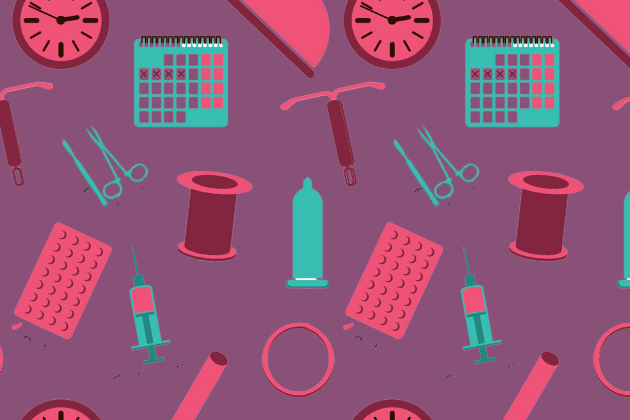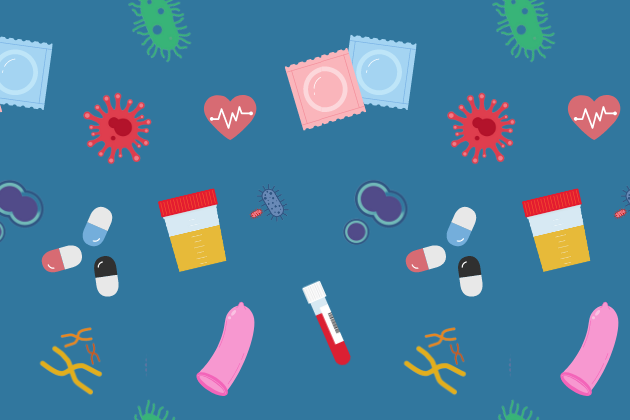
Risk is a normal part of life—and STIs are too! You take risks all the time, including every time you get in a car, cross the street, or go on a trip. Assessing, analyzing, and evaluating the risks and the benefits of the situations you face is a normal part of life.
When thinking about having sex, there are social, emotional, and physical risks as well as benefits to consider for any scenario. Having accurate information allows you to make informed decisions about the level of risk you are okay with and what you can do to control how much risk an activity has.
Like most things in life, your comfort with different levels of risk depends on context and can change over time. Having the skills, information, and resources to look at both the benefits (e.g., pleasure, fun, intimacy) and risks can help you to make decisions you feel good about.
Overemphasizing risk and making everything sound scary does not help to assess it. Risk is something to be informed about, not something to be afraid of.
This section includes information on ways to reduce the risk of getting or passing an STI.
Got questions about STIs? Call or text our Access Line.
Dental Dams
A dental dam is a square piece of latex, polyisoprene, vinyl, or nitrile that you can place over an anus or vulva* to reduce the chances of getting or passing STIs during oral sex. Dental dams reduce the chances of getting or passing STIs by covering the skin around your mouth, genitals, or anus and reducing skin-to-skin contact, and potentially by preventing fluids from a body part that might have an STI from coming in contact with a partner’s body.
You can sometimes get dental dams for free from sexual health clinics or buy them at sex shops (including online). If you don’t have a dental dam when you need it, you can make one by cutting a non-lubricated condom or medical glove or using non-microwaveable plastic food wrap.
Dental dams are most effective at reducing the chance of getting or passing STIs if:
- You use a new dam for each person and each act of sex.
- You keep track of which side of the dam is used on the vulva/anus and which side the mouth is touching if you move or adjust it.
- They cover the area where you get outbreaks for things like herpes or HPV (STIs that are passed by skin-to-skin contact).
External Condoms
An external condom is a latex, polyisoprene, or polyurethane sheath that you can roll onto a penis* or sex toy to reduce the chances of getting or passing STIs during oral, anal, or vaginal sex. External condoms reduce the chances of getting or passing STIs by preventing fluids from a body part that might have an STI from coming in contact with a partner’s body and by reducing skin-to-skin contact in the areas the condom covers.
You can often get external condoms for free at sexual health clinics or you can buy them at pharmacies, corner stores, sex shops (including online), and sometimes in vending machines.
External condoms are most effective at reducing the chance of getting or passing STIs if:
- You use a new condom for each person and each act of sex.
- You use lube - it can make condoms less likely to break.
- You check the expiration date and use unexpired condoms.
- You store them in a cool location.
- You avoid oil-based lubricants with latex or polyisoprene condoms. Oil can break down the latex/polyisoprene and can make the condom more likely to break.
- You don't double up on condoms. Two condoms rubbing against each other makes more friction and can make them more likely to break.
- You make sure to leave some room near the tip for ejaculate/cum if you are using a condom on a penis.
- You pinch the air out of the tip of the condom before rolling it on and make sure you aren’t getting air bubbles inside the condom.
- You check sometimes to make sure the condom hasn’t broken or slipped.
Internal Condoms
An internal condom is a nitrile or polyurethane sheath with a flexible ring at each end that you can insert into an anus or vagina* to reduce the chances of getting or passing STIs during sex with a penis or sex toy. Internal condoms reduce the chances of getting or passing STIs by preventing fluids from a body part that might have an STI from coming in contact with a partner’s body and by reducing skin-to-skin contact in the areas the condom covers.
You may be able to get internal condoms for free at sexual health clinics, or buy them at sex shops (including online).
Internal condoms are most effective at reducing the chance of getting or passing STIs if:
- You use a new condom for each person and each act of sex.
- You use lube - it can make condoms less likely to break.
- You check the expiration date and use unexpired condoms.
- You store them in a cool location.
- You don't double up on condoms. Two condoms rubbing against each other makes more friction and can make them more likely to break.
- You check sometimes to make sure the condom is still in place.
Other Methods
Sometimes making a plan for how you want to manage your chances of getting or passing STIs can make it easier to act on that plan later. Thinking about what you want to do ahead of time, understanding what feels comfortable for you, what levels of risk feel okay, and how you would like to feel afterwards, can help you create boundaries that help make sex feel safe and pleasurable for you.
Things you can consider when planning include:
- If you are HIV-positive, taking HIV medication consistently can reduce the amount of virus in your system to the point where you are unable to pass the virus on to others through sex.
- If you are HIV-negative, PrEP (Pre-Exposure Prophylaxis) is a daily dose of HIV medication that can reduce the chances of getting HIV from partners who might have it. PEP (Post-Exposure Prophylaxis) is a daily dose of HIV medication that can be started up to 72 hours after coming in contact (or potentially coming in contact) with HIV to reduce the chance of getting HIV.
- Talking with partners or potential partners about when you (and they) got tested last. Sharing your results and the chances you have come in contact with any STIs since your last test can help plan what strategies you may want to use to lower the chances of getting or passing an STI.
- You can choose when to use condoms or dental dams, or any other strategies to lower the chances of getting or passing an STI. Maybe you want to use them when you are more concerned an STI might be present and maybe you don't when you are less concerned an STI might be present.
- Getting tested for STIs regularly is a way to know your status and get treated if you have an STI. Many STIs are curable, which means once you have finished treatment you don’t have them anymore and can’t pass them to partners. For many STIs that are not curable, treatment can lower or eliminate the chances of passing them on.
- Using lube can reduce friction caused by skin rubbing together. Friction can cause small tears in the skin, which makes for an easy spot for STIs to get in. Less friction means skin is less likely to tear.
- You can reduce how much each partner’s bodily fluids come in contact with the other’s mucous membranes by ejaculating/cumming outside of the vagina, mouth, or anus.
- Different kinds of sex have different levels of risk for passing STIs. Sex with condoms or dental dams, grinding, handjobs, fingering, mutual masturbation, or using sex toys are all less likely to pass STIs. Penetrative penis in vagina or penis in anus sex without condoms are more likely to pass STIs.
- Douching right before or right after sex can cause irritation of the tissue in the vagina or rectum, which can make it easier to get or pass STIs. Avoiding douching can help lower that risk.
- Drugs like poppers (amyl nitrate) dilate blood vessels in the rectum, which can make it easier to get or pass some STIs during anal sex. Avoiding poppers before sex can help lower that risk.
- Rougher sex can cause tears in the skin, which can make it easier to get or pass some STIs. Avoiding rougher sex can help lower that risk.
- HIV is more likely to be transmitted from an insertive partner to a receptive partner than the other way around. If you are HIV-positive and your partner is HIV-negative, you can reduce the chances of passing HIV by choosing to be the receptive partner. If you are HIV-negative, you can choose to be the insertive partner.
* Not everyone uses these words for their body parts or relates to them in the same way. We have used these words as they are commonly known and encourage you to use the language that feels best for you.

